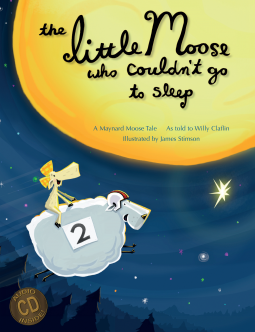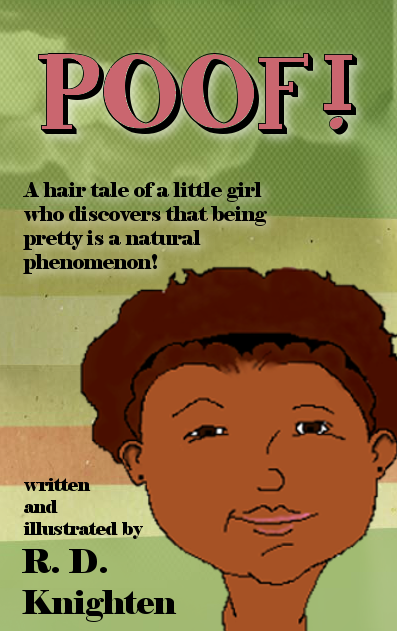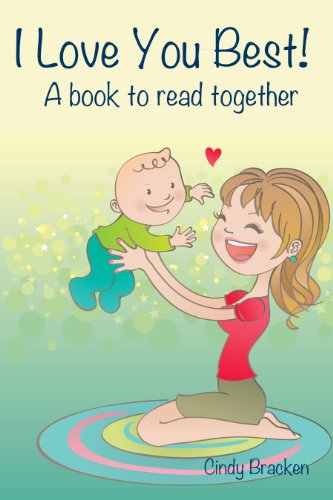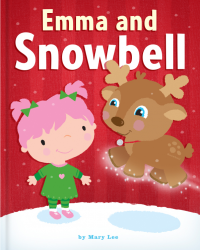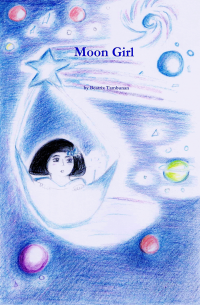The Little Moose Who Couldn’t Go to Sleep. Willy Claflin. James Stinson, ill. 2014. 36 pages. August House. [Source: ARC provided courtesy of NetGalley.] A book “as told to” a human by a moose that has an accompanying CD and needs a glossary? That is just enough of a departure from the norm for me to check it out. From the minute we dove in, I knew this book was a treat. The foreword is cute. I like the idea of the story and way it’s told being authentic to the person (or animal) who told it. I think that sets up a good precedent for readers who may venture into other cultures’ stories (think Canterbury Tales). I would have loved to heard the accompanying CD, but I think you get a fairly good feel for it from the story.
Poof! R.D. Knighten. 2013. 27 pages. Gembay Books. [Source: personal copy.] A friend sent this book to me, thinking it would be a great topic for me and my daughter. Poof is a short story that follows a day in the life of Robin, a little girl of color, and her unexpected romp in the rain. When her beautiful braids poof up after a rain storm, she’s upset that her cute hairstyle is no more. Robin talks to her friend Leslie whose own hair became wavy in the rain. Together the two girls compare the benefits of each hair type, coming to an understanding about how the differences have their own pluses and minuses. Later, Robin talks to her own mother about her hair, eventually realizing how her hair texture allows her to be stylish and creative, when she just thought it lost its beauty.
I Love You Best. Cindy Bracken. 2012. 16 pages. [Source: personal copy.] I picked up I Love You Best because it was a free daily deal on Amazon. While I found it enjoyable, it’s not too remarkable. There’s nothing technically wrong with it, but it lacks a wow factor for me. I Love You Best highlights different animals and what they love, whether it’s their habitat, fellow animals, foods, or more. It is definitely a shorter read, but not so short that it’s over before you’re able to get into it. Considering the content and structure, I found it to be well-done. I enjoyed the ability to have peripheral conversations about the content of this story. Since it discusses various animal homes or environments and different animal-related terms (e.g. foal, cud), it was natural to stop and ask whether my reader knew what certain words meant if she didn’t ask me herself. The illustrations are computer animated, but bright and colorful; they strike a balance between simplicity and detail. The illustrations also feature different drawing styles, so the variety there is unusual and refreshing. Some are more detailed than others, which I think lends well to the different animals on…
Emma and Snowbell. 2013. 28 pages. Sweet Lemon Books. [Source: ARC provided courtesy of StoryCartel.] In a nutshell, this book is just in time for the holiday season, and if you have a child who loves to sing, this will be great family fun! Emma and Snowbell is a simple story about a girl and her reindeer. She’s stuck in the snow, and without a sled to get around, she picks a live ride instead. They soar throughout town, having fun with her classmates along the way. The book can be read, but is best when sung to the tune of “Jingle Bells.”
Moon Girl. Beatrix Tambunan. 2012. 31 pages. [Source: ARC provided courtesy of StoryCartel.] Moon Girl follows a young girl whose primary focus in life is lighting up the Earth’s moon alongside her older sister Sun Girl, who lights up the sun. She lives in her sister’s shadow and begins questioning her place in the world, her acceptance from others and her self-worth. Eventually, she leaves to find a place where she can be truly appreciated and valued for what she has to offer. At its core, Moon Girl is a story about self esteem and self-worth in the face of difference. It examines how people view themselves in their world and helps you understand that you have unique place in the world that can only be filled by you. It also helps you reflect on how important it is to show appreciation for someone’s contributions, even though they may not see it themselves.

